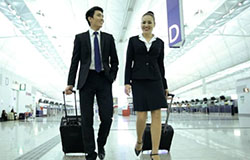Business travelers feel 50% safer at airports than at train or subway stations
 Global business travelers feel more nervous at train or subway stations than at airports, according to the latest research commissioned by CWT.
Global business travelers feel more nervous at train or subway stations than at airports, according to the latest research commissioned by CWT.
Business travelers are most worried about subways and train stations (50%), walking (42%), ridesharing services (39%), buses (39%), taxis (36%), and trains (35%). These are six of the ten top areas of concern – ahead of airports (34%), airplanes (31%), eating out (30%) or hotels (27%). Travelers from the U.S. are most worried about subways and train stations (56%), while Canadian travelers are the least worried (38%).
“Travel managers should focus their safety and security programs on what travelers worry about most,” said Christophe Renard, Vice President of CWT Solutions Group, the consultancy arm of Carlson Wagonlit Travel. “Small things like providing clear instructions on getting out of the airport, trustworthy suppliers, basic tips on how to address dangerous situations – these can all make a big difference.”
Ridesharing services versus taxis
As ridesharing services like Uber become more common, displacing traditional taxis, travelers now make little distinction between the two. Travelers still feel marginally safer in taxis, though. Travelers from Asia Pacific are the most concerned overall: 43% feel nervous using ridesharing services and 39% are uneasy when taking a taxi. In the Americas, the numbers are 40% and 39% respectively, and in Europe 34% and 28%. US travelers are the most concerned (44%), while Canada travelers are the least concerned (31%).
Female business travelers in Europe and Asia Pacific are more likely to feel nervous about personal safety when using ridesharing services or taxis than men.
Taking a closer look at ridesharing, 56% of women from Asia Pacific feel very or somewhat nervous versus 38% of men. Taxis make business travelers from Asia Pacific less nervous – 48% of women and 35% of men feel very or somewhat vulnerable when hailing a cab service. In Europe, the differences are less pronounced. For ridesharing, 38% of females versus 31% for males are very or somewhat nervous compared to 36% versus 22% for those utilizing a taxi service. In the Americas, there is no statistical difference between genders.
Even though ridesharing is associated with the younger generation, the findings show that these travelers are more concerned about personal safety. Millennials in all regions are the most worried, followed by gen X travelers and baby boomers.
In Asia Pacific, half of the millennial travelers are very or somewhat concerned when using a ridesharing service, followed by 44% of gen X and 35% of boomers. In the Americas, 47% of millennials, 42% of gen X and 29% of boomers are very or somewhat concerned when using rideshares. In Europe, the numbers drop to 44%, 34% and 21%, respectively.
These differences might be down to gender. According to the research, gender differences appear to track the differences seen between generations. This may be because males are more likely to travel for business the older they get, but the opposite is true of female business travelers. The younger women are, the more likely they are to travel for business.
source: eTN




